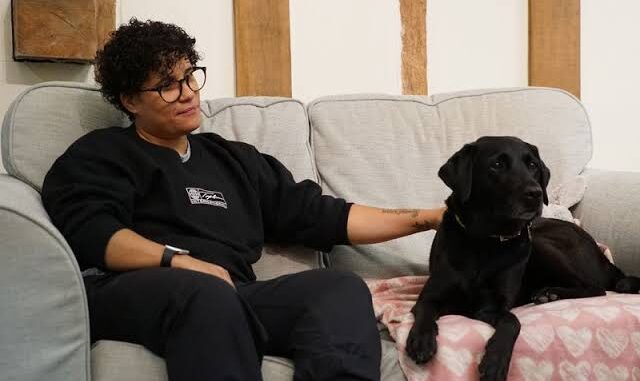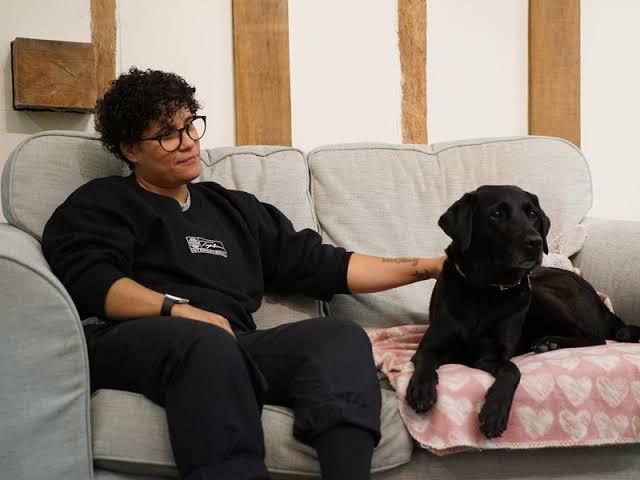
How to Teach Your Dog to Stay Calm Around Guests: Welcoming guests into your home should be an enjoyable experience not a chaotic one filled with barking, jumping, or nervous pacing from your dog.

Whether your dog is overly excited, fearful, or aggressive around visitors, the key to a calm greeting lies in preparation, consistency, and training. This guide will walk you through a comprehensive approach to teaching your dog to stay calm when guests arrive and stay.
Why Dogs React Strongly to Guests
Before diving into the training, it’s important to understand why dogs behave the way they do around unfamiliar people:
- Excitement: Some dogs love people and simply can’t contain their enthusiasm.
- Fear or anxiety: Others may feel threatened or uncertain about strangers in their territory.
- Protectiveness: Dogs can be instinctively territorial, barking or guarding when someone enters.
- Lack of training: Often, dogs just haven’t learned what’s expected of them during guest interactions.
Identifying the root cause will help you tailor your training approach.
Step-by-Step Training: Teaching Your Dog to Stay Calm Around Guests
1. Start with Basic Obedience
A calm dog starts with solid fundamentals. If your dog hasn’t mastered basic commands, you’ll have a hard time managing them around guests.
Focus on these commands:
- Sit
- Stay
- Down
- Place (go to a specific spot, like a mat or bed)
- Leave it
- Come
Practice these daily in a calm, distraction-free environment before introducing any real-life guest scenarios.
2. Create a “Calm Zone” or Safe Space
Designate a space where your dog can retreat and feel relaxed. This can be a bed, crate, or quiet room.
Train your dog to go to this space on cue. Use commands like:
- “Go to your mat.”
- “Place.”
- “Crate.”
Start rewarding your dog for staying in this spot quietly, even without guests. Use treats, praise, or a favorite chew toy.
3. Desensitize to Door Triggers
Many dogs react to doorbells, knocking, or even the sound of keys. Desensitize your dog gradually:
- Play the sound of a doorbell or knocking on your phone or have someone help you.
- When your dog hears it, reward calm behavior.
- If your dog reacts excitedly, ignore the behavior until they calm down, then praise.
Repeat until the sound no longer provokes a strong reaction.
4. Practice Controlled Guest Interactions
Once your dog understands basic commands and is comfortable with the idea of guests, practice calm greetings:
Use a helper first (friend or family member):
- Have your dog on a leash or behind a baby gate.
- Instruct the guest to ignore the dog completely at first—no eye contact, petting, or talking.
- Ask your dog to sit or go to their place before allowing any interaction.
- Only when your dog is calm should the guest acknowledge them—and even then, calmly and briefly.
If your dog jumps or barks:
- Redirect to “sit” or “down.”
- Keep the leash loose, but under control.
- Avoid punishment—it increases anxiety or confusion.
5. Reward Calmness, Not Excitement
Dogs learn through association. If your dog gets attention, treats, or play when they’re hyper, they’ll continue that behavior.
Instead:
- Ignore hyper behavior.
- Reward calmness: quiet sitting, lying down, or focused attention.
- Use calming rewards: petting, low-key praise, long-lasting chews.
6. Manage Energy Before Guests Arrive
Tired dogs are calm dogs. Before expecting good behavior around visitors:
- Go for a walk or play fetch
- Provide a puzzle toy or chew
- Engage in basic training sessions
Burning off energy beforehand helps your dog make better choices when guests arrive.
7. Use Management Tools if Needed
During early stages of training, tools can help manage your dog’s behavior:
- Leashes: Keep your dog leashed when guests arrive to prevent jumping or lunging.
- Baby gates: Allow your dog to observe without direct contact.
- Crates: Some dogs feel safer and calmer in their crate.
- Calming aids: Consider calming collars, pheromone diffusers (like Adaptil), or anxiety vests.
8. Be Patient and Consistent
Changing behavior takes time. Set realistic expectations and avoid inconsistent training. For example:
- Don’t allow jumping sometimes and scold it at others.
- Don’t let guests “undo” your training by encouraging wild greetings.
Practice regularly, even when guests aren’t coming over, by simulating scenarios with family members or neighbors.
READ ALSO: How to Treat Yeast Infections in Dogs
Special Considerations for Anxious or Aggressive Dogs
If your dog growls, hides, or shows signs of stress around guests, you may need a slower approach:
- Use distance: Let the dog observe from a safe zone.
- Provide calming enrichment: like a stuffed Kong or lick mat during guest visits.
- Avoid forcing interaction: Allow the dog to choose to approach, or not.
- Consult a professional trainer or behaviorist, especially if aggression is involved.
Signs Your Dog Is Becoming Calm and Comfortable
- Responds to commands even when guests are present
- Lies down or remains in a designated spot during visits
- Doesn’t bark or rush the door when the bell rings
- Greets people calmly or waits to be approached
Celebrate these moments with calm praise or quiet rewards. Over time, your dog will associate visitors with positive, stress-free experiences.
Troubleshooting Common Problems
Problem: My dog always jumps on guests.
- Use a leash for controlled greetings.
- Teach an alternate behavior like “sit” when the door opens.
- Instruct guests to turn away and ignore jumping.
Problem: My dog gets too excited and won’t listen.
- Increase exercise beforehand.
- Practice guest scenarios in short sessions.
- Reinforce basic commands in distracting environments.
Problem: My dog barks nonstop at new people.
- Use “quiet” training: reward when barking stops.
- Redirect to a chew toy or “place” command.
- Reward silence, not barking.
FAQs
Why does my dog go crazy when guests arrive?
Dogs often get excited or stressed when their environment changes. New smells, sounds, and people create stimulation overload. Without proper training, they express this energy through barking, jumping, or pacing.
Should I punish my dog for barking or jumping?
No. Punishment can make your dog fearful or confused, especially if they’re anxious. Instead, redirect to a positive behavior and reward calmness. Positive reinforcement leads to long-term behavior change.
How do I stop my dog from barking at the doorbell?
Desensitize your dog to the sound by pairing it with treats in controlled practice sessions. Teach a replacement behavior like going to their mat or sitting quietly. Consistency is key.
Can my dog learn to be calm if they’ve been reactive for years?
Yes! Even older dogs can learn new behaviors with time and patience. The process may take longer, especially if habits are deeply ingrained, but calmness is achievable with structured training and consistency.
What if my dog is aggressive toward guests?
Aggression is serious. Avoid forcing interactions and consult a certified professional dog trainer or veterinary behaviorist. You may need a personalized behavior modification plan to address underlying fear or territoriality.
Should I let my guests give my dog treats?
Yes if your dog is not fearful or reactive. Having guests toss treats without direct interaction can help build positive associations. Always monitor your dog’s comfort level.
How long does it take to train a dog to be calm with visitors?
It varies by dog. Some dogs may improve in weeks, while others take months. Factors include age, temperament, consistency, and history. Focus on progress, not perfection.
Leave a Reply
You must be logged in to post a comment.